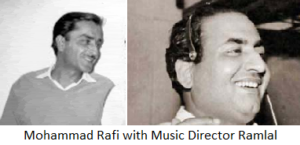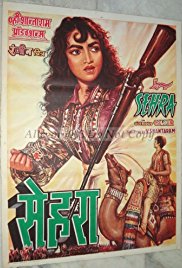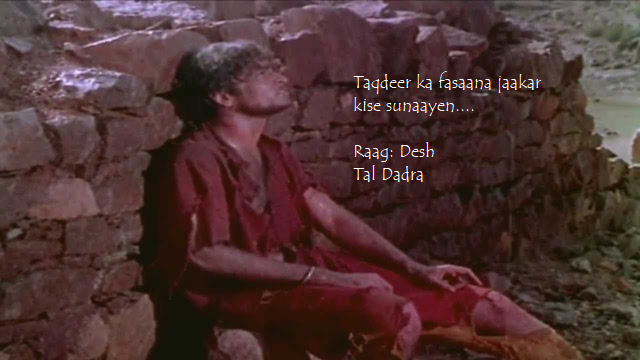Raaga Based Song of the Day: Taqdeer ka fasaana jaakar kise sunayen….
Raag Desh, Tal Dadra
I had given you a song in Raag Desh earlier on the 15th day (Beqasi hadd se jab guzr jaaye) (Please see: ‘Raaga Based Song Of The Day #15‘). However, even at that time I had clarified that it was anything but pure Desh and indeed was a cross between Desh and Khammaj. Today’s song, however, is a fine example of Desh.
 It is also signature Mohammad Rafi with his passion, outstanding voice and ability to go to high pitch with ease. Everytime I return to Mohammad Rafi, I keep thinking that there was and is no one with his calibre of singing. He was the one for whom we can use the word incomparable, doing it full justice. This one is with a forgotten music director Ramlal who gave us remarkably beautiful songs in this movie Sehra as well as in Geet Gaya Pathron Ne (both V Shantaram movies); songs such as: Tum to pyaar ho sajani, Pankh hote to udd aati, Ja ja ja re tujhe ham jaan gaye, Tere khayaalon mein ham, and Mandve tale gareeb ke do phool khil rahe hain.
It is also signature Mohammad Rafi with his passion, outstanding voice and ability to go to high pitch with ease. Everytime I return to Mohammad Rafi, I keep thinking that there was and is no one with his calibre of singing. He was the one for whom we can use the word incomparable, doing it full justice. This one is with a forgotten music director Ramlal who gave us remarkably beautiful songs in this movie Sehra as well as in Geet Gaya Pathron Ne (both V Shantaram movies); songs such as: Tum to pyaar ho sajani, Pankh hote to udd aati, Ja ja ja re tujhe ham jaan gaye, Tere khayaalon mein ham, and Mandve tale gareeb ke do phool khil rahe hain.
We have completed sixty days of Raaga Based Songs of the Day. Our first post in the series was titled ‘Raaga Based Song Of The Day #1’ and the song was a Mohammad Rafi and Lata Mangeshkar song from the 1970 Shakti Samanta movie Pagla Kahin Ka: Tum mujhe youn bhula na paoge. It is in Raag Jhinjhoti, Tal Kaherava.
Our sixtieth post or the last post was titled ‘Raaga Based Song Of The Day #60‘ and the song was a Udit Narayan and Kavita Krishnamurthy song from the 2001 S Shankar movie Nayak: The Real Hero starring Anil Kapoor and Rani Mukerji: Chalo chalen mitwa in oonchi neechi raahon mein. It is in Raag Gawati, Tal Kaherava.
This blog has a number of posts on Raaga based songs in Hindi movies titled similarly; for example: ‘The Best Raaga Based Songs in Hindi Movies – Raaga Bhairavi – Part III‘.
In the last sixty days of sharing Raaga based songs of the day, I have given you songs based on Raag Jhinjhoti, Gara, Bhimpalasi, Madhuvanti, Shivaranjani, Bihag, Pahadi, Sarang, Pilu, Bhairavi, Khammaj, Charukesi, Kalyan or Yaman, Desh, Malgunji, Kirwani, Kedar, Bageshri, Megh Malhar, Bhupali, Ahir Bhairav, Malkaush, Mand, Adana, Kafi, Rageshri, Jaunpuri, Tilang, Janasammohini, Chayanat, Shuddha Kalyan, Gaur Sarang, Jogiya, Asavari, Maru Bihag, Durga, Lalit, Puria Dhanashri, Bhinna Sahdja, Sohani, Multani, Patdeep, Jaijaiwanti, Tilak Kamod, Hemant, Basant Mukhari, Gujri Todi, Kalavati, Hamir, Bhatiyar and Gawati. The only five raagas that have been repeated so far are Pahadi, the raaga of my home place in the Himalayas, Maru Bihag, Raag Kirwani, Jhinjhoti and Bhairavi. That makes a total of 51 raagas so far. Today, I am repeating Raag Desh.
Today, I give you a song sung by Mohammad Rafi on the lyrics of Hasrat Jaipuri and on a composition by Ramlal. As I said, it is in Raag Desh, Tal Dadra.
However, first, lets take up the value added learning of today. Today, we shall learn about Classification of Indian Musical Instruments.
Now that we have, over a period of time, got a smattering of Indian musical instruments, today, lets learn something about their classification.
In the NatyaShastra of Bharat Muni, the musical instruments are classified in four groups:
1. Tat Wadya: String instruments.
2. Sushir Wadya: Blowing instruments.
3. Awanadhha Wadya: Percussion instruments made with animal skin.
4. Ghan Wadya: Solid instruments or Cymbals (A-tonal instruments) made by hard surfaces such as metal, and wood.
1. Tat Wadya: In the earlier stage, the strings were made up with weeds, animal skins, hair, etc. After the technique of making metal strings was invented, it made great advancement. Ancient mythology states that string instruments were formed by the bow of Shiva. One can interpret it as when the ancient man got to know the sound of bow string while releasing the arrow out of it, the idea of making a musical instrument might have struck in his head and then he made such bow shaped string instrument. The frequency depends upon the length of the string and also on the distance of the string from the sound bridge. After a lot of experimentation, man started making the ancient Veena, ie, lute. The instruments such as Tanpura, Veena, Sitar, Sarod, Sarangi, Israj, Dilruba are string instruments. These string instruments are further divided into 4 categories:
a. Plucked instruments such as Tapnura, Swar-Mandal, etc.
b. Stroking instruments such as Sitar, Sarod, etc and
c. Bowed instruments such as Sarangi, Israj, Violin,
d. Hammered instruments such as Santoor.
2. Sushir Wadya: ‘Sushir’ means a hole, so the instruments having holes from which air is blown for sound production are called ‘Sushir Wadya’. These instruments have an air column made up with bamboo, wood or metal, to which there are holes for producing notes. The blown instruments are further divided into two categories:
a. Simple blown instruments such as Flute, Shankh, Tutaari;
b. Blown instruments with reeds such as Shehnai, Sundri.
3. Awanadhha Wadya: ‘Awanadhha’ means ‘to cover over or conceal’, so these instruments have a sound box with covering of skin. The ‘Bhoomi Dundudhi’ is the most ancient instrument of such kind. According to the making and playing technique, the percussion instruments are divided such as:
a. Played with stroke of fingers such as Khanjira, Duff, Dimdi.
b. Played with stroke of a stick such as Dhol, Sambal, Nagada.
c. Played with the palms of both the hands, such as Pakhawaj, Mridangam.
d. Played with a thread attached at the middle portion with holding at centre point, such as Damroo.
e. Played with palms as well as fingers, such as Tabla, Dholki, Dholak.
4. Ghan Wadya: ‘Ghana’ means solid, so these instruments are solid in state, not hollow in shape. These instruments are made with a variety of materials such as stone, bones, horns, wood, and metals. These instruments are further classified in 3 groups. They are:
a. Played with contact, such as Chipli, Taal.
b. Played with a stick or hammer, such as JalTarang, KaashthaTarang, Ghanta.
c. Played with rotation or free movement, such as Ghunghroo, Ghantika, Rattle, and Kabas.
Though they have attractive tonal quality, these solid instruments are basically a-tonal, i.e., they cannot produce various notes on the same instruments, so they are used for maintaining the tempo or rhythm. So, one can find the use of solid instruments in other genres such as folk, film music, applied music rather than in classical music.
In modern era with the advent of some new instruments in India, two new categories are added to these traditionally accepted four categories:
a. Keyboard instruments – such as Harmonium, Organ, Piano, which are basically European instruments.
b. Electronic instruments – we have many electronic musical instruments, including electronic Tanpura, electronic Tabla and so on.
As I mentioned, today’s song is composed in Raag Desh, Tal Dadra.
Raag Desh or Des belongs to Khammaj Thaat. Its Jati is Audhav-Sampurna, that is five notes in Aaroha (minus Gandhar and Dhaivat) and all seven notes in Avaroha. It is sung during the second prahar of the night, that is, between 9 PM and midnight. This Raag is a very sweet melody that announces itself with the combination D s m G R – G ,N s S. The musical compositions in this Raag bear the Shadja-Pancham (S-P) and Shadja-Madhyam (S-m) Bhava and therefore very pleasing and essentially melodic.
Desh has been used in patriotic songs; the most popular being a version of Vande Mataram, the national song.
Some of the songs composed in this raag Desh are:
| 1. 2. 3. 4. 5. 6. 7. 8. 9. 10. 11. 12. 13. 14. 15. 16. 17. 18. 19. 20. 21. 22. 23. 24. 25. 26. 27. 28. 29. |
Udi Hawa Mein Jati Dukh Ke Din Ab Bekasi Had Se Jab Le Ja Meri Duayein Gori Tore Nain Saiyaan Jao Chali Re Chali Chali Aaj Gori Zamane Ka Dastoor Abke Baras Tu Jo Mere Sur Mein Zindagi Pyar Ki Aapko Pyar Chupane Main To Saanwarein Ki Morey Naina Bahaye Mrignayani Chandramukhi Hindola Jhule Shyam Kaun Rokega Ab Chal Diye Deke Gham Ulajh Gaye Do Naina Hum Tere Pyar Mein Sara Chali Kaun Se Desh Dekhi Zamane Ki Yaari Thandi Thandi Saawan Ki Kadam Chale Aage Rani Khol De Apne Mana Mere Hanseen Sanam Mere Pyar Mein Tere Pyar Ko Is |
Achuut Kanya Devdas Kalpana Deedar Main Suhagan Hoon Jhanak Jhanak Payal Baje Saranga Godaan Lajawaab Bandini Chitchor Anarkali Neela Aakash Meera Bawarchi Rang Birangi Shatranj Ke Khiladi Ek Kali Muskaee Son Of India Ek Saal Dil Ek Mandir Boot Polish Kagaz Ke Phool Jaagte Raho Bhakt Surdas Tadbeer Adventures Of Robinhood Maan Maine Jeena Seekh Liya |
Devika Rani K. L. Saigal Asha Bhosle Lata Mangeshkar Rafi, Asha Lata Mangeshkar Asha Bhosle Lata Mangeshkar Mukesh, Lata Asha Bhosle Yesudas, Hemlata Hemant Kumar Asha, Rafi Vani Jayaram Lata Mangeshkar Vasant Rao, Fayyaz Khan Chorus Lata Mangeshkar Lata Mangeshkar Lata, Hemant Kumar Lata Mangeshkar Talat Mehmood, Lata Mohd. Rafi Asha Bhosle K. L. Saigal K. L. Saigal, Suraiya Mohd. Rafi Lata Mangeshkar Mukesh |

The song Taqdeer ka fasaana jaakar kise sunayen is from the 1963 V Shantaram movie Sehra starring his wife Sandhya with Prashant.
The song was penned by Hasrat Jaipuri and composed by Ramlal. It was sung separately by Mohammad Rafi and Lata Mangeshkar. I am giving you the Mohammad Rafi version.
Please enjoy in Raag Desh, Tal Dadra: Taqdeer ka fasaana jaakar kise sunaayen….
Taqadiir kaa fasaanaa jaakar kise sunaa_e.n
Is dil me.n jal rahii hai.n aramaan kii chitaa_e.n
Saa.Nso.n me.n aaj mere tuufaan uTh rahe hai.n
Shahanaa_ii_o.n se kah do kahii.n aur jaa ke gaa_e.n
Is dil me.n jal rahii hai.n aramaan kii chitaa_e.n
Matavaale chaa.Nd suuraj teraa uThaaye Dolaa
Tujhako khushii kii pariyaa.N ghar tere le ke jaa_e.n
Is dil me.n jal rahii hai.n aramaan kii chitaa_e.n
Tum to raho salaamat seharaa tumhe mubaarak
Meraa har ek aa.Nsuu dene lagaa duaa_e.n
Is dil me.n jal rahii hai.n aramaan kii chitaa_e.n
We have intended to learn about Raaga based music whilst we entertain ourselves with Raaga based songs. So, lets, once again, take stock of our collective learning so far:
- On the first day we learnt about the Raaga system devised by Pandit Vishnu Narayan Bhatkhande, which is the prevalent system in Hindustani Classical Music and based on ten Thaats.
- On the second day we learnt about Tal or Taal.
- On the third day we learnt about characteristics of Raagas that included Swar, Jati, Thaat, Arohana and Avarohana, Vadi, Samvadi and Pakad.
- On the fourth day, we learnt about Sargam.
- On the fifth day, we learnt about notations used in Indian classical music or simply Swar Lipi.
- On the sixth day, we learnt about the Ras (sentiments) that Raagas evoke.
- On the seventh day, we learnt about various types of Swar: Shuddha, Achal, Vikrut, Komal and Teevra.
- On the eighth day, we learnt the parts of a composition in Indian Classical Music.
- On the ninth day, we learnt the names of some of the popular instruments used in Indian Classical Music.
- On the tenth day, we learnt about the sources of names of Raagas.
- On the eleventh day, we learnt about why Bhairavi is the first raag to be taught to beginners and also why it is the last in a performance.
- On the twelfth day, we learnt about Khammaj Thaat.
- On the thirteenth day, we learnt about Tal Punjabi Theka or Sitarkhani.
- On the fourteenth day, we learnt about Alap.
- On the fifteenth day, we learnt about List of Raagas (Raagmala) in my favourite book: Sri Guru Granth Sahib.
- On the sixteenth day, we learnt about tips for raaga identification.
- On the seventeenth day, we learnt the basics of Gharana system.
- On the eighteenth day, we learnt about Filmi Sangeet.
- On the nineteenth day, we learnt about the commonest Tal in Raagas: Tintal.
- On the twentieth day, we learnt about the Kafi Thaat.
- On the twenty-first day, we learnt a little more in detail about the classification of Raagas.
- On the twenty-second day, we learnt the essential differences between Bhairavi and Bhairav.
- On the twenty-third day, we learnt a little more in detail about the Jati or Jaati of a raaga.
- On the twenty-fourth day, we learnt details of Thaat Bilawal, the most basic thaat in the Bhatkhande’s system of raagas.
- On the twenty-fifth day, we learnt about Tintal.
- On the twenty-sixth day, we learnt in detail about the Raaga – Samay linkage.
- On the twenty-seventh day, we learnt about Lehar.
- On the twenty-eighth day, we learnt about the history of the Hindustani Music.
- On the twenty-ninth day, we learnt about Dhrupad.
- On the thirtieth day, we learnt about Rupaktal that I was introduced to, a few months back, by my friend Anand Desai.
- On the thirty-first day, we learnt about Khayal.
- On the thirty-second day, we learnt about Thumri.
- On the thirty-third day, we learnt about Tappa.
- On the thirty-fourth day, we learnt about Tarana.
- On the thirty-fifth day, we learnt about Tal Dipchandi (Moghali).
- On the thirty-sixth day, we learnt about Tabla.
- On the thirty-seventh day, we learnt about Kirtan.
- On the thirty-eighth day, we learnt about Pakhawaj.
- On the thirty-ninth day, we learnt about Hori.
- On the fortieth day, we learnt about Dadra.
- On the forty-first day, we learnt about Kajri.
- On the forty-second day, we learnt about Chaiti.
- On the forty-third day, we learnt about Sarangi.
- On the forty-fourth day, we learnt about Shehnai.
- On the forty-fifth day, we learnt about Sarod.
- On the forty-sixth day, we learnt about Bansuri.
- On the forty-seventh day, we learnt about Ektal and Tanpura.
- On the forty-eighth day, we learnt about Veena.
- On the forty-ninth day, we repeated our learning of Veena with a small excitement added.
- On the fiftieth day, we learnt about Dilruba/Esraj.
- On the fifty-first day, we learnt about Jaltarang.
- On the fifty-second day we learnt about Qawwali.
- On the fifty-third day, we learnt about Sitar.
- On the fifty-fourth day, we learnt about Surbahar.
- On the fifty-fifth day, we learnt about Harmonium.
- On the fifty-sixth day, we learnt about Santoor.
- On the fifty-seventh day, we learnt about Swarmandal.
- On the fifty-eighth day, we learnt about the Shruti Box.
- On the fifty-ninth day, we learnt about Alankar.
- On the sixtieth day, we learnt about singing in Aakaar.
- And today, on the sixty-first day, we learnt about the Classification of Indian Musical Instruments.
There is much more still to be learnt and enjoyed.
Please stay tuned!

As always, it’s a pleasure to read your posts. I’m so glad I chanced upon the blog several years ago and have been following the posts since then.
Thank you Amy.
Exceedingly well. Now these raga based songs posts has become readers’ delght . Providing a kind of cathsrsis usually felt a gaining some new knowledge . Superb .
Thank you, Jaswant; I am doing my best to revive interest in classical music.